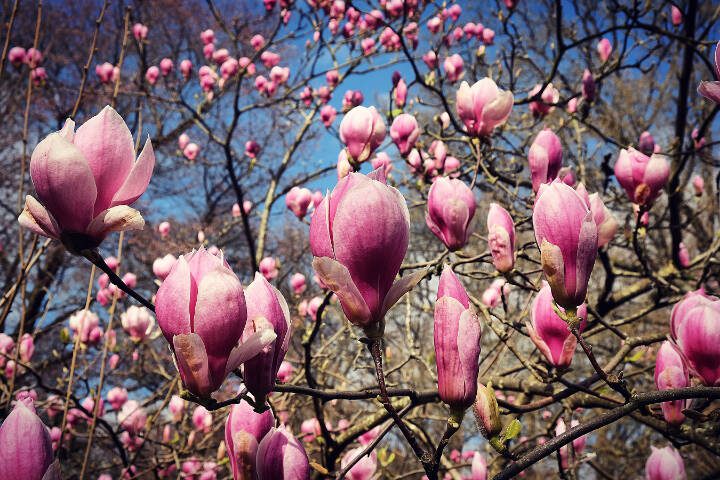Magnolias offer us gardeners some spectacular options for our Pacific Northwest landscapes.
Many types are beginning to bloom now as we near the end of winter and head toward spring, bursting to life in a variety of colors and flower forms. Most are deciduous and bloom on bare wood before the foliage emerges in spring.
Perhaps you visited the Northwest Flower and Garden Festival in Seattle a couple weeks back. Magnolias are always a popular choice for the designers there, and various varieties could be seen in bloom in the show gardens. With more than a couple hundred species across the globe, and countless other hybrids and cultivars, there are certainly plenty of flavors of magnolia to quench any gardener’s appetite.
In general, magnolias like a good, mostly sunny location in well-drained soil. These plants are what we call “old-wood bloomers” — they grow furry flower buds each summer and then the buds open up the following spring. Keep this in mind as you prune; cutting them back in winter means you remove much of the flowers for the next spring.
Follow my simple pruning rule that has very few exceptions: Prune after bloom. Pruning after flowering means the plant can grow, set buds and never skip a year of flowering. In addition, give them a good dose of granular organic fertilizer once in March and again in early June, both of which will help keep them thriving and producing maximum flower power season after season.
One final thing to keep in mind: Don’t let magnolias dry out in summer. A drought-stressed magnolia, and one that is not fed properly, may abort flower bud production in summer, which means minimal flowering the following spring.
Magnolias certainly come in all shapes and sizes, and often can be grown as either a multi-stem shrub or as a traditional single-trunk tree. Often the same variety will be available both ways, allowing you to choose the form that best matches your taste. Multi-stems grow a bit wider and with not as much height, typically offering (to me) a more “native” look. Tree forms, on the other hand, offer less spread and mature into taller, stately focal points in the landscape. Either way, you are growing a specimen with stunning flowers and sometimes even fragrance. Here are a few options worthy of garden consideration:
Star magnolias (or magnolia stellata and cultivars): These are blooming now and offer quite a showy, early flower display. Flowers are mainly white, such as Royal Star, but some varieties can be found that are kissed with pink, such as Centennial Blush. These are great examples of magnolias that can be grown up as a tree or, more often found, as a multi-trunked smaller tree/large shrub specimen. They grow slowly, are very manageable and mature in the 12- to 15-foot-tall range, after a number of years.
Saucer magnolias (or magnolia x soulangeana and cultivars): These classic, old-fashioned magnolias are often mistakenly called “tulip trees” — real tulip trees are liriodendron and grow huge with yellow flowers — and sport larger, chalice-shaped flowers in a range of colors. This old-school species is flushed in pink and will grow large with age to over 20 feet tall, and also much wider.
Hybrid magnolias: The above two species — and many others, frankly — have been crossed and hybridized over the years into countless worthy cultivars in all sorts of growth habits, flower colors and flowering times. Consider your options here, for sure. A number of them can be found at local nurseries in spring, including Black Tulip, Genie, Rose Marie, Butterflies, Sunsation, Vulcan, Burgundy Star and Felix Jury. I encourage you to look these up, as I’m sure that, like me, you will be in awe of the variety of colors and growth habits.
The girls series: The National Arboretum has introduced a number of cultivars in this group over the years, all with showy flowers — blooming a couple weeks after typical Star or Saucer magnolias — and a more compact size for modern landscapes. Often ones such as Betty, Susan and Ann can be found at local nurseries each spring. These options will mature in the 12- to 15-foot-tall range and can be found in multi-stem or single-trunk form, as well.
Evergreen magnolias (or magnolia grandiflora and cultivars): These often are known as “southern magnolias” — if you like golf, like me, think Magnolia Lane at the Masters in April — and sport large, glossy deep-green foliage and huge, fragrant white flowers in the heat of summer. They can also take a bit heavier soil and more moisture than other magnolias. Look at your local nursery to find some nice, small options, keeping in mind that the species will grow to more than 50 feet tall and wide with age. I would suggest a few such as Teddy Bear, Little Gem, Bracken’s Brown and Victoria, but there are also a number of other good, hardy varieties for the Pacific Northwest.
Free class
Sunnyside Nursery in Marysville will host “Spring Lawn Care” at 10 a.m. on Saturday, March 9. For more information or to sign up, go to www.sunnysidenursery.net/classes.
Trevor Cameron is a certified professional horticulturist (CPH) and serves as general manager for Sunnyside Nursery in Marysville. He can be reached at sunnysidenursery@msn.com.
Talk to us
> Give us your news tips.
> Send us a letter to the editor.
> More Herald contact information.

























